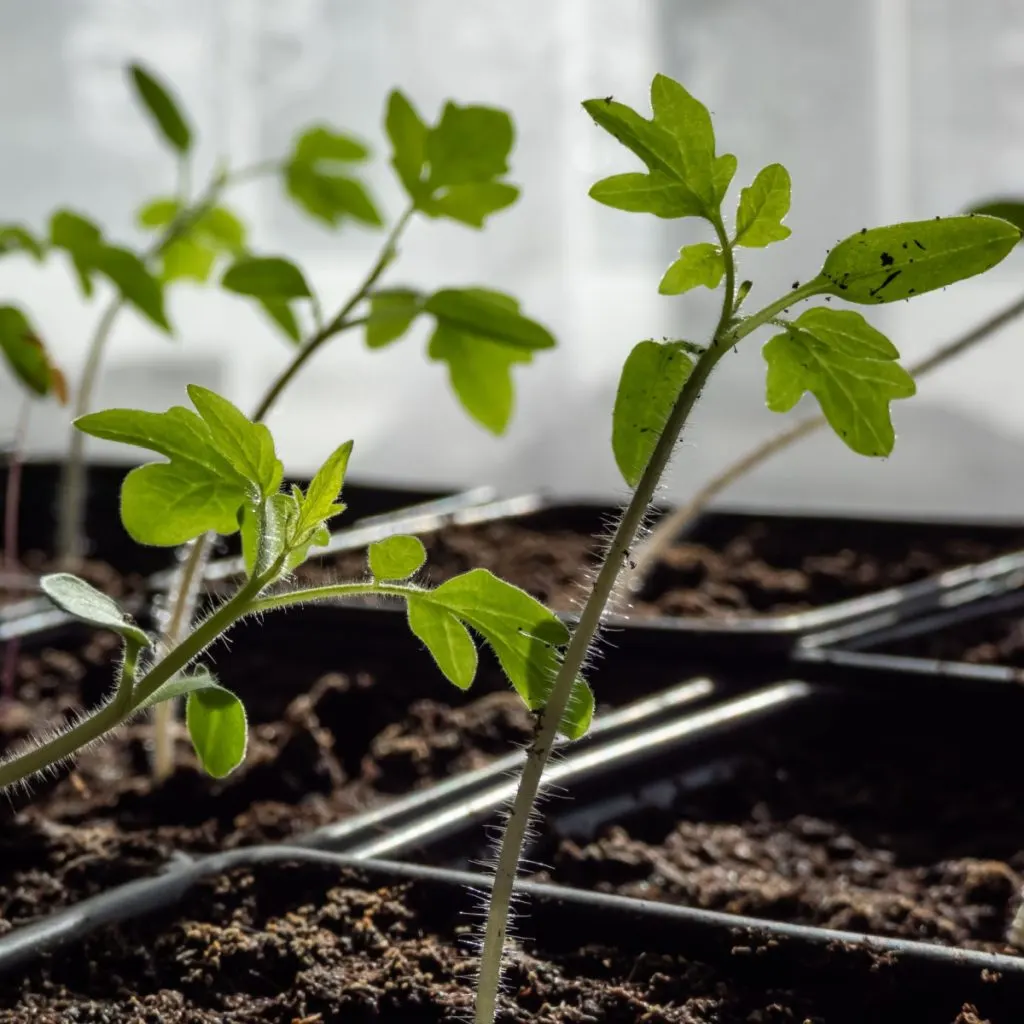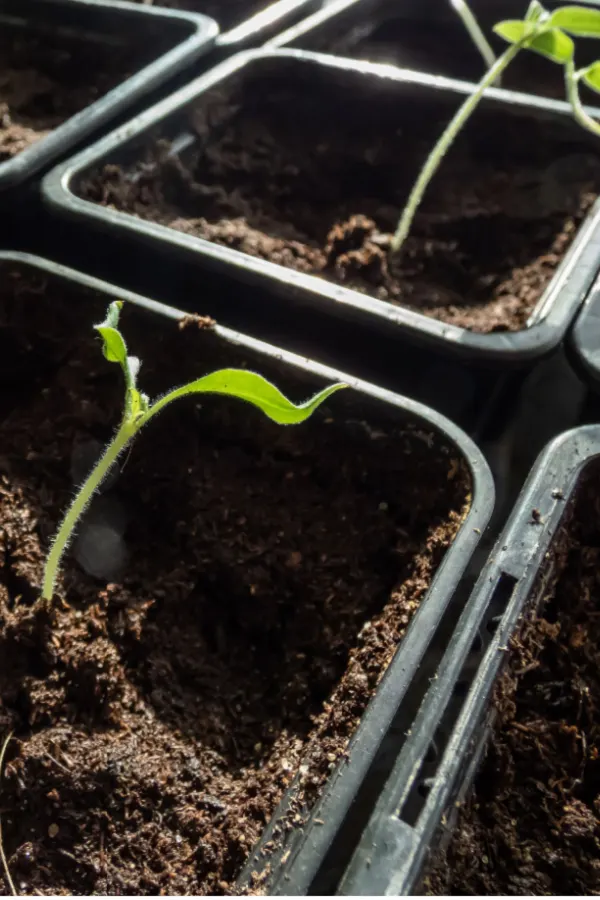When it comes to starting seeds indoors and growing healthy, strong transplants for your garden and flowerbeds, did you know that the one place you should not start and grow your plants from seed is in a window?
Although it may seem like a natural fit to grow seedlings in a sunny windowsill, as it turns out, it can create all kinds of issues for your plants. Not just in the short term while starting and growing indoors, but for your plant’s long term health and success as well!
Starting your own vegetable and flower plants from seed indoors is a great way to get a jump start on the growing season. It can also be a great way to save money as well. Even better, growing your own plants from seed opens up your world to hundreds of plant varieties you just can find in stores in the spring.

But if there is one thing that many gardeners struggle with, it’s getting their seedlings off to a great start indoors. And all too often, one of the biggest culprits is trying to grow them in a sunny windowsill.
Unfortunately, starting and growing annuals in a window is simply not a good idea. And, as you will see below, for a very long list of reasons. With seed starting success in mind, here is a look at why to keep your seedlings out of your window, and where to start them instead to grow with ease!
Why Not To Start Seeds In Windows
The Problem With Growing In A Sunny Window
So why is a sunny window so bad for seeds and seedlings? Although there are many reasons, let’s start with the single biggest reason of all – the sunlight coming through the window.
When seeds first germinate and pop through the soil, the first thing they begin to look for is light. Quite naturally, they instantly want to grow toward that light. And that is exactly where problems begin for young seedlings.

The sunlight coming through a window pane is a long way away. So far that the seedling has to continually stretch toward it. Adding to the issue, the sun moves across the sky quickly in late winter when most gardeners are starting their seeds. That means the seed leans even more following the sun.
Because of this, seedlings that grow in windows become long and spindly. They also constantly lean and bend, making them incredibly weak in the process. And even if you turn them in the window each day to correct the lean, they simply grow even longer and thinner trying to bend back toward the sun again.
Additional Issues With Windowsill Growing – Why Not To Start Seeds In Windows
Weak plants are unfortunately not the only issue caused by growing in a window. Because temperatures fluctuate quickly between hot sunlight during the day and dark chilly overnights in late winter and early spring when seeds are planted, it can often lead to seeds taking longer to germinate.
Why? Because the constant hot and cold soil delays sprouting. In addition, once they do sprout, seedlings also struggle to develop strong roots and stems with the constant fluctuations in temperatures.
And if all of that wasn’t enough, the hot sun’s rays coming through at mid-day can often burn the tender young foliage of transplants if they happen to be too close to the window. All the more reason to not keep your seedlings in the window!
Listen In To Our Podcast Below On How To Start Seeds Indoors!
So now that we know windows are not the best place to grow your seedlings, let’s take a look at where and how you should grow them. The good news? It’s easier than you might ever think!
How & Where To Start Seeds Indoors – Why Not To Start Seeds In Windows
Without a doubt, the best way to start and grow seeds indoors is with artificial light. But that doesn’t mean you need special or expensive lights to do it. Vegetable and annual flower plants do not require a special light spectrum to grow. That means there is little need for fancy, specialized grow lights.
In fact, basic, inexpensive LED or fluorescent ceiling or shop lights work incredibly well for starting seeds. Plus, they are quite inexpensive to operate. And do they ever grow strong, healthy transplants with thick stems and lush growth! Affiliate Link: 4FT Linkable LED Shop Lights
The key with with using shop lights is to keep them close overhead of the growing plants. For seedlings, this means placing the lights about an inch from the top of the foliage. Unlike when growing in a windowsill, this allows young seedlings to grow slowly upwards – and not have to stretch to the light source.

Setting Up A Seed Starting Area – Why Not To Start Seeds In Windows
For best results, when starting seeds indoors, begin by selecting the warmest room of your house. The more consistent the heat the better. Seeds and young seedlings like to be between 65° and 75° Fahrenheit. It will help them both germinate more quickly and grow at a faster clip.
Since you will be using artificial light, the room does not need to have windows. You can use a basic seed starting stand that holds lights, or simply place your seed trays on the ground. See: DIY Tabletop Seed Starting Plans
Whatever your set-up, the important thing is to keep the artificial lights close to the top of your plants. If not using a stand that holds lights, set the plants on the floor and use blocks or bricks to keep lights above the tip of the foliage. As plants grow, continue to move the lights up.
By using this type of lighting method, with proper water and care, your plants will grow even and steady. And even more importantly, strong and healthy!

Hardening Off Transplants – Why Not To Start Seeds In Windows
Once you are a few weeks away from planting day, begin to move your plants outdoors to harden them off. Hardening off is the process of getting plants acclimated to the outdoor conditions. See: How To Harden Off Plants – Why Hardening Off Is A Must For Young Transplants
This is an extremely important final step as it allows tender young plants the ability to slowly prepare for life outdoors. As the weather allows, keep plants outside longer each day. When planting day arrives, your transplants will be ready to grow!
Follow Our Facebook Page For Even More Great Tips! Simple Garden Life Facebook Page
Simple Garden Life is a website dedicated to keeping gardening fun, simple and enjoyable! We publish two new articles each week along with a new garden podcast episode every two weeks. This article may contain affiliate links.
